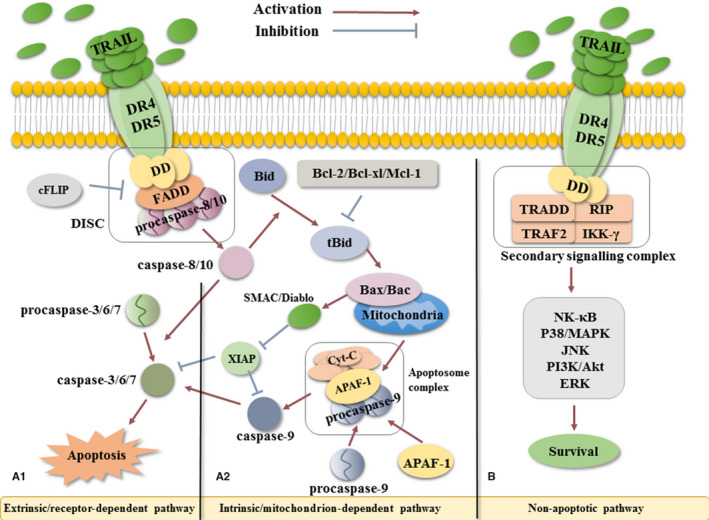Figure 1.

The TRAIL signalling pathway. A, Apoptotic signalling pathway. The binding of soluble TRAIL to the homotrimer of DR4/5, the DD on receptors, the recruited FADD and pro‐caspase 8 form the DISC complex, which triggers autocatalytic activation of caspase 8 in DISC. Subsequently, in (A1) extrinsic pathway, caspase 8 activates caspase 3/6/7 directly; in (A2) intrinsic pathway, caspase 8 cleaves Bid into tBid which later interact with Bax/Bac on the mitochondrial membrane leading to lysis of mitochondria. The Cyt‐C released from mitochondria cleaves pro‐caspase 9 into caspase 9 in apoptosome complex, which in turn activates caspase 3/6/7. The effector caspase 3/6/7 activated by both pathways induces cell apoptosis. B, Non‐apoptotic signalling pathway. Adaptor proteins including TRADD, TRAF2, RIP1 and IKK‐γ are recruited to form the secondary signalling complex through a serious complex processes involving several molecules such as NF‐κB, P38/MAPK, JNK, PI3K/Akt and ERK. These pathways induce cell survival, proliferation and migration among other processes. APAF‐1, apoptotic protease–activating factor‐1; Bcl‐2, Bcl‐XL, Mcl‐1, Bac, Bax all belong to Bcl‐2 family, B cell leukaemia 2 family; Bid, BH3 domain–containing protein; c‐FLIP, cellular FADD‐like IL‐1β–converting enzyme inhibitory protein; DISC, death‐inducing signalling complex; DR4/5, death receptor 4/5; ERK, extracellular regulated kinase; FADD, Fas‐associated death domain; IKK‐γ, inhibitor of κB (IκB) kinase‐γ; JNK, c‐Jun N‐terminal kinase; MAPK, mitogen‐activated protein kinases; NF‐κB, nuclear factor kappa‐light‐chain‐enhancer of activated B cells; PI3K, phosphatidylinositide 3‐kinases; RIP1, receptor‐interacting kinase 1; tBid, truncated Bid; TRADD, TNFR1‐associated death domain; TRAF2, TNF receptor–associated factor 2; TRAIL, TNF‐related apoptosis‐inducing ligand; TRAIL‐R, TNF‐related apoptosis‐inducing ligand receptor; XIAP, X‐linked inhibitor of apoptosis protein
